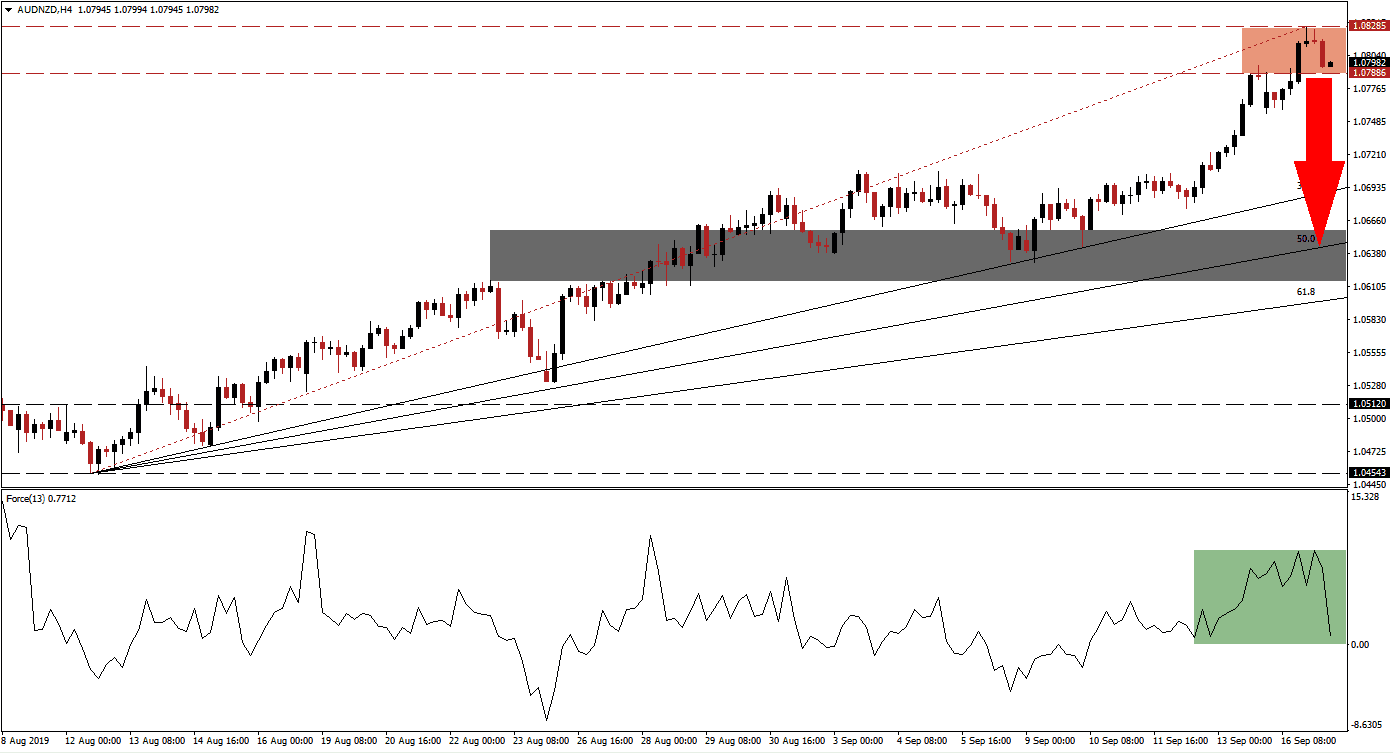The Australian Dollar, home to a bigger and more diversified economy than the New Zealand economy, has enjoyed a strong rally against its smaller neighbour the New Zealand Dollar; both are considered commodity currencies and both are dependent on the Chinese economy. Over the past six weeks the AUD/NZD has rallied aggressively from an intra-day low of 1.02620 and the rally took a breather and restarted from an intra-day low of 1.04543, which forms the starting point of the Fibonacci Retracement Fan Support Levels. Bullish momentum has now started to fade and the rally appears to be exhausted which could lead to a sell-off inside its resistance zone.
What is the Fibonacci Retracement Fan?
The Fibonacci Retracement Fan is a different visualization of the Fibonacci retracement sequence which outlines important support and resistance levels in technical analysis. Those levels warrant a closer look and offer entry and exit levels for trades together with other aspects of the analysis.
The Force Index, a next generation technical indicator, has formed a long and shallow negative divergence as the most recent peak was lower than the previous one while price action extended its rally. The sudden drop in this indicator, as marked by the green rectangle, suggests that bulls are losing control of price action and a move below the 0 center line is expected to preceded a breakdown in the AUD/NZD below its resistance zone. Give the current magnitude of the drop in the Force Index, a break in its uptrend is expected to lead to a lower low as compared to its previous one.
What is the Force Index?
The force index is considered a next generation technical indicator. As the name suggests, it measures the force behind a move. In other words, forex traders will get a better idea behind the strength of bullish or bearish pressures which are driving price action. The indicator consist of three components (directional change of the price, the degree of the change and the trading volume). This creates an oscillator which in conjunction with other aspects of technical analysis provides a good indicator for potential changes in the direction of price action. It subtracts the previous day closing price from today’s closing price and multiplies it by the volume. Strong moves are supported by volume and create the most accurate trading signals.
Price action is now approaching the bottom range of its resistance zone, marked by the red rectangle. Momentum in the Force Index is pointing towards a move below 0, which would put bulls in charge, which is expected to result in a breakdown in the AUD/NZD below its resistance zone. This will end the uptrend and the 38.2 Fibonacci Retracement Fan Support Level could act as a magnet for this currency pair. Forex traders are likely to realize floating trading profits which will further add selling pressure and push a bigger reversal. The 1.07886 level, the bottom range of its resistance zone, should be closely monitored.
What is a Resistance Zone?
A resistance zone is a price range where bullish momentum is receding and bearish momentum is advancing. They can identify areas where price action has a chance to reverse to the downside and a resistance zone offers a more reliable technical snapshot than a single price point such as an intra-day high.
Given the strength of the rally in the AUD/NZD, a sell-off should be expected to retrace part of this advance. A successful breakdown below its resistance zone confirmed by a breakdown in the Force Index will open the path for price action to correct back down into its next support zone, marked by the grey rectangle, which is located between 1.06158 and 1.06584. The 50.0 Fibonacci Retracement Fan Support Level is also currently located inside of this support zone.
What is a Breakdown?
A breakdown is the opposite of a breakout and occurs when price action moves below a support or resistance zone. A breakdown below a resistance zone could suggest a short-term move such as profit taking by forex traders or a long-term move such as a trend reversal from bullish to bearish. A breakdown below a support zone indicates a strong bearish trend and the extension of the downtrend.
AUD/NZD Technical Trading Set-Up - Breakdown Scenario
Short Entry @ 1.07850
Take Profit @ 1.06350
Stop Loss @ 1.08300
Downside Potential: 150 pips
Upside Risk: 45 pips
Risk/Reward Ratio: 3.33
A breakout above its resistance zone is highly unlikely as the Force Index confirms the loss in bullish momentum. A new fundamental catalyst would be required to force an extension of this exhausted rally as the technical picture favors a price action reversal. Any potential push above resistance will most likely be limited to its next intra-day high of 1.09394, the bottom range of its next resistance zone from where a previous sell-off and subsequent breakdown in the AUD/NZD originated. The Force Index should be closely monitored together with fundamental news flow in order to assess if a short-term, limited breakout is possible.
What is a Breakout?
A breakout occurs if price action moves above a support or resistance zone. A breakout above a support zone could signal a short-term move, such as a short-covering rally which occurs when forex traders exit short positions and realize trading profits, or a long-term move such as the start of a trend reversal from bearish to bullish. A breakout above a resistance zone signals strong bullish momentum and an extension of the existing uptrend.
AUD/NZD Technical Trading Set-Up - Limited Breakout Scenario
Long Entry @ 1.08350
Take Profit @ 1.09350
Stop Loss @ 1.07950
Upside Potential: 100 pips
Downside Risk: 40 pips
Risk/Reward Ratio: 2.50

